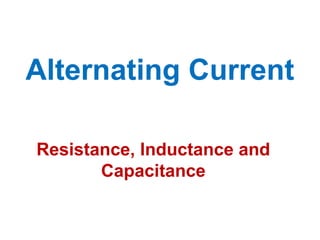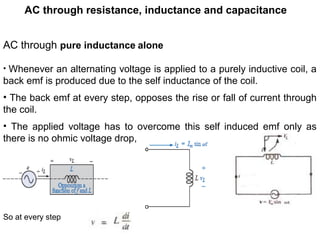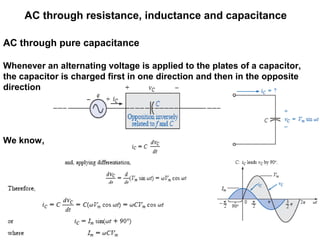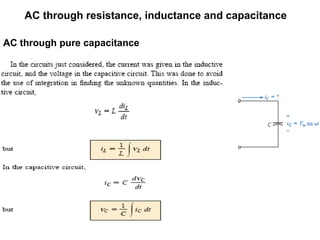Ac current
- 1. Alternating Current Resistance, Inductance and Capacitance
- 2. AC through resistance, inductance and capacitance • AC through ohmic resistance alone Let the voltage v(t) = Vm sin ωt is applied to a pure resistor R Let i = instantaneous current. Applied voltage has to supply ohmic voltage drop only. Hence, for equilibrium, v = iR = Vm sin ωt •Current, i is maximum when sin ωt is unity. So • Hence i = Im sin ωt • Alternating voltage and current are in phase with each other
- 3. AC through resistance, inductance and capacitance • Power in ohmic resistance alone Instantaneous power, p = v i = (Vm sin ωt)(Im sin ωt) = Vm Im sin2 ωt = (Vm Im/2) (1- cos 2ωt) = Vm Im/2 - (Vm Im/2) cos 2ωt • Power consists of a constant part = Vm Im/2 and • a fluctuating part (Vm Im/2) cos 2ωt of double frequency For a complete cycle, the average value of (Vm Im/2) cos 2ωt = 0 Hence, power for the whole cycle is P = (Vm Im/2) = (Vm/√2) Im/√2) P = V x I watt Where V = rms value of applied voltage and I = rms value of the current
- 4. AC through resistance, inductance and capacitance • AC through ohmic resistance alone
- 5. AC through resistance, inductance and capacitance • AC through ohmic resistance alone Ex: A 60 Hz voltage of 115 V (r m s) is impressed on a 10 Ω resistor. (i) Write down the time expression (equation) of voltage v(t) and the resulting current i(t). Sketch v(t) and i(t).
- 6. AC through resistance, inductance and capacitance AC through pure inductance alone • Whenever an alternating voltage is applied to a purely inductive coil, a back emf is produced due to the self inductance of the coil. • The back emf at every step, opposes the rise or fall of current through the coil. • The applied voltage has to overcome this self induced emf only as there is no ohmic voltage drop, So at every step
- 7. AC through resistance, inductance and capacitance AC through pure inductance alone Now So Hence,
- 8. AC through resistance, inductance and capacitance AC through pure inductance alone If applied voltage Then resulting current Vectorially • Clearly, the current lags behind the applied voltage by a quarter cycle (as shown, or the phase difference between is π/2 with voltage leading. • Here, Im = (Vm/ωL) = (Vm/XL) . Hence ωL plays the part of resistance. It is called the inductive reactance XL of the coil and is given in ohms if L is in henry and ω is in radian/second.
- 9. AC through resistance, inductance and capacitance AC through pure inductance alone •current lags behind the applied voltage by π/2 • inductive reactance XL= ωL Power • It is clear that the average demand of power from the supply for a complete cycle is zero. Power wave is a sine wave of double frequency. Maximum instantaneous power is
- 10. AC through resistance, inductance and capacitance AC through pure inductance alone •current lags behind the applied voltage by π/2 • inductive reactance XL= ωL • average demand of power from the supply is zero • Energy is stored in one half cycle and • releases in the next half cycle
- 11. AC through pure inductance Ex: A sinusoidal voltage of v = 100 Sin 20t is Applied across a 0.5 H inductor. What is the sinusoidal expression for the current? Inductive reactance, Ex: A sinusoidal voltage of v = 100 Sin 20t is Applied across a 0.5 H inductor. What is the sinusoidal expression for the current? Inductive reactance,
- 12. AC through pure inductance
- 13. AC through resistance, inductance and capacitance AC through pure capacitance Whenever an alternating voltage is applied to the plates of a capacitor, the capacitor is charged first in one direction and then in the opposite direction We know,
- 14. AC through resistance, inductance and capacitance AC through pure capacitance
- 15. AC through resistance, inductance and capacitance AC through pure capacitance In Ohm’s law format • Capacitive reactance is the opposition to the flow of charge, which results in the continual interchange of energy between the source and the electric field of the capacitor. • Like the inductor, the capacitor does not dissipate energy in any form
- 16. AC through resistance, inductance and capacitance AC through pure capacitance
- 17. AC through resistance, inductance and capacitance AC through pure capacitance
- 18. AC through resistance, inductance and capacitance AC through pure capacitance Ex: A voltage of v = 3- Sin 400t is applied across a 1 µF capacitor. What is the sinusoidal expression for the current?
- 19. AC through resistance, inductance and capacitance AC through pure capacitance Ex: A current I = 40 Sin (500t +60 ) is impressed on a 100 µF capacitor. What is the sinusoidal expression for voltage?
- 20. AC through resistance, inductance and capacitance AC through pure capacitance: Power Instantaneous power p = vC iC = Vm sin ωt.Im sin(ωt + π/2). = Vm Im sinωt cos ωt = ½ Vm Im sin 2ωt Power for the whole cycle = ½ Vm Im sin 2ωt dt = 0 So, in a purely capacitive circuit, the average power demand from power supply is zero. Also power wave is a sine wave of frequency double that of the voltage and current waves. Maximum value of the instantaneous power is = Vm Im/2.



















